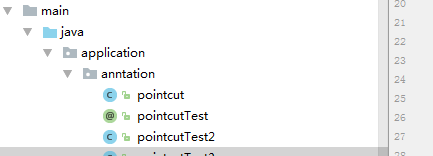一:自定义注解型
1:自定义注解类:
@Retention(RetentionPolicy.RUNTIME)
public @interface pointcutTest {
}
2:
@Aspect
@Component
@Order(0)
public class pointcut {
//此处两种写法
//一:
// @Pointcut("@annotation(application.anntation.pointcutTest)")
// public void pointcut(){}
//二:打开上面注释,将下面的@annotation(application.anntation.pointcutTest)替换成pointcut()
@Before("@annotation(application.anntation.pointcutTest)")
public void beforeRunning() {
System.out.println("pointcutTest1 @before方法开始前执行");
}
@Around("@annotation(application.anntation.pointcutTest)")
//此处注意有返回时 around需添加object的返回值,不然会导致原来的返回值不返回
public Object beforeExecute(final ProceedingJoinPoint joinPoint) throws Throwable {
Object obj = null;
try {
System.out.println("pointcutTest1 @around方法开始前执行1");
System.out.println(JSON.toJSONString(joinPoint.getArgs()));
//.proceed()此处为通知处理,会先去执行before方法,切点进来后会先进入around方法
obj = joinPoint.proceed();
System.out.println("pointcutTest1 @before方法执行后执行");
} catch (Exception e) {
// logger.error("发生异常: ", e);
System.out.println("方法执行错误");
}
return obj;
}
@After("@annotation(application.anntation.pointcutTest)")
public void after(final JoinPoint joinPoint) {
try {
System.out.println("pointcutTest1 @after方法执行后执行");
} catch (Exception e) {
// logger.error("发生异常: ", e);
System.out.println("方法执行错误");
}
}
@AfterReturning("@annotation(application.anntation.pointcutTest)")
public JoinPoint afterExecute(final JoinPoint joinPoint) {
try {
System.out.println("pointcutTest1 @AfterReturning方法执行后执行");
} catch (Exception e) {
// logger.error("发生异常: ", e);
System.out.println("方法执行错误");
}
return joinPoint;
}以上,所有加了@pointcutTest注解的方法都会被切到,进行增强处理
二:无注解标识,主动切
@Aspect
@Component
@Order(2)
public class pointcutTest2 {
@Pointcut("execution(* application.controller.test.test())")
public void pointcut(){}
@Before("pointcut()")
public void beforeExecute(final JoinPoint joinPoint) {
try {
System.out.println("pointcutTest2 @Before 方法开始执行");
} catch (Exception e) {
// logger.error("发生异常: ", e);
System.out.println("方法执行错误");
}
}
@Around("pointcut()")
public Object beforeExecute(final ProceedingJoinPoint joinPoint) throws Throwable {
Object obj=null;
try {
System.out.println("pointcutTest2 @around方法开始前执行");
System.out.println( JSON.toJSONString(joinPoint.getArgs()));
obj= joinPoint.proceed();
System.out.println("pointcutTest2 @Before方法执行后执行");
} catch (Exception e) {
// logger.error("发生异常: ", e);
System.out.println("方法执行错误");
}
return obj;
}
@AfterReturning(pointcut = "pointcut()",returning = "fileurl")
public JoinPoint afterExecute(final JoinPoint joinPoint ,String fileurl) {
try {
System.out.println(fileurl);
System.out.println(JSON.toJSONString(joinPoint.getArgs()));
System.out.println("pointcutTest2 AfterReturning方法执行后执行");
} catch (Exception e) {
// logger.error("发生异常: ", e);
System.out.println("方法执行错误");
}
return joinPoint;
}
}
自定义方法,添加注解@Pointcut("execution(* application.controller.test.test())"),此注解表示切test类里面的test方法,当执行test方法时,就会进行增强处理
三:对于可以使用配置的文件的项目,可使用配置文件实现切点
此种方法跟上面第一种一样,是自定义注解方法的配置文件形式
1、<bean id="pointcutTest" class="application.anntation.pointcut"/>
指定处理类
2、<aop:pointcut id="pointcut" expression="@annotation(application.anntation.pointcutTest)"/>
指定自定义的注解
3、<aop:aspect id="brokerAction" order="0" ref="pointcutTest">
<aop:around pointcut-ref="pointcut" method="beforeExecute"/>
</aop:aspect>
指定执行的方法及处理时机
指定执行的时间 before、around、after
order 当同一个方法被多个切点切时的执行顺序,数字越小越先执行
method 指定执行哪一个方法
四:execution详解
示例一:
<aop:pointcut id="serviceMethod" expression="execution(* *..*Service.*(..))">
第一个* 表示任意返回值类型
第二个*表示以任意名字开头的package,如com.xx
第三个*表示以任意名字开头的class的类名 如TestService
第四个*表示通配*Service下面的任意class
最后的..表示通配方法可以有0个或者多个参数
示例二:
execution(* com.aptech.jb.epet.dao.hibimpl.*.*(..))
这样是匹配hibimpl包下面的所有的类的所有方法
第一个* 表示任意返回值类型
第二个*表示所有的类
第四个*表示所有的方法
最后的..表示通配方法可以有0个或者多个参数
使用execution时可以切一个类里面的全部方法,或者一个包里面全部类里面的全部方法,也可以切单个方法,使用@annotation时,可以自由的给想要切的方法标识注解,两种方法按实际场景需求选择。
转载于:https://blog.51cto.com/11745766/1971796






















 6516
6516











 被折叠的 条评论
为什么被折叠?
被折叠的 条评论
为什么被折叠?








